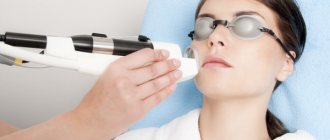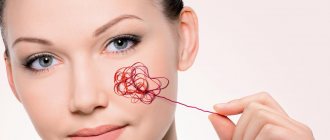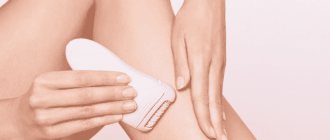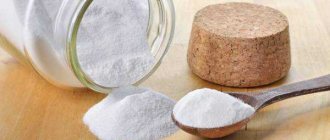Principle of operation
The principle of waxing is based on pulling out hairs from the roots using an adhesive mixture containing oils and resins. The latter components provide hair grip, and the former provide care and hydration. The product is applied to the skin, then a strip is applied and abruptly torn off from the area.
There are several types of these products on the market, but not all are suitable for home use. Some require a special heating device - a wax melter.
The choice of product depends on which area of the body will be treated . Use hot, warm and cold wax. The higher the temperature of the product, the less discomfort. This is due to the ability of heat to reduce pain.
The waxing kit includes the following items:
- Cartridges or jars with the product are used in different densities depending on the area being depilated.
- Wax melter - the device heats the required amount of product to a certain temperature.
- Spatula - will be needed when working with a product that is sold in cans.
- Strips - Fabric and paper strips are intended for waxing. They are applied after applying the mixture according to hair growth and are torn off along with it. Strips up to 20 cm are suitable for the bikini area and legs.
- Cosmetic wipes - remove product residues and care for the skin, nourishing, moisturizing and relieving irritation. They contain various extracts, vitamins and essential oils.
Contraindications
It is not recommended to epilate your legs if:
- diabetes mellitus;
- varicose veins;
- low blood clotting;
- allergies to wax components;
- the presence of any damage to the skin, including acne;
- the presence of any neoplasms.
Irritation after waxing
It is recommended to consult a doctor while pregnant, since waxing your legs increases the risk of an unexpected reaction to the painful process.
How does the procedure work?
The home hair removal technique is not a complicated one. The procedure for hair removal using wax takes place in several successive stages:
- Stage 1 – preparing the skin for hair removal. The treated area is degreased and disinfected using a pre-depilatory agent;
- Stage 2 – applying the mixture using a spatula in the direction of hair growth;
- Stage 3 – removal against hair growth;
- Stage 4 – removing residues using special oil;
- Stage 5 – restoration of the skin using emulsion or cream.
Note! After the depilation process itself, you can apply oil to slow down hair growth.
Homemade wax recipe
How to make depilatory wax at home using improvised means:
Recipe No. 1 - complex
You will need two types of wax - carnauba (360 gr.) and beeswax (130 gr.), glycerin (7 ml.).
Preparation is carried out as follows:
- for more precise control of the process, the ingredients should be melted in a water bath until a homogeneous mass is formed;
- the resulting mixture is cooled slightly to 40 degrees and glycerin is added;
- To add a pleasant aroma, add essential oil (2-3 drops).
Recipe No. 2 – honey-lemon
The honey and lemon based recipe is quite effective and suitable for the bikini area. Required set of products for waxing: half a lemon, honey (300 g). Preparation occurs in the following sequence:
- squeeze lemon, mix with honey;
- add water (100 ml.) and mix thoroughly;
- put the mixture on fire, after a couple of minutes add water again (100 ml);
- cook until syrup thickens. Cool slightly and use as intended.
Recipe No. 3 - sugar
Necessary ingredients: sugar (500 grams), paraffin - 50 grams, lemon (2 pcs.), glycerin (1.5 tsp).
How to prepare depilatory wax at home:
- squeeze juice from lemons, add sugar and paraffin;
- put on fire and wait until sugar and paraffin are completely dissolved;
- add glycerin;
- bring to a thick syrup and remove from heat;
- Apply to the body while warm, wait until it hardens, then remove with strips.
Recipe No. 4 - effective
Necessary products for preparing depilation wax at home: honey (100 g), paraffin (50 g), rosin (150-200 g).
Place all ingredients in a bowl and heat until melted. You can use a wax melter for preparation. Next, the mixture is removed from the heat and cooled to 40-45 degrees.
Suitable for rough areas of skin – legs and arms.
What do women say?
Hand depilation, the reviews of which are very extensive, is very popular at home. Women advise each other on various hair control methods, and we have chosen the most popular recipes to create this article. With them, hair removal on your hands will become much more pleasant and cheaper; from the many tips on combating vegetation, every representative of the fair sex will be able to choose the ideal one for herself. The special beauty of the recipes described above is the natural and affordable ingredients that will not harm delicate women’s skin, unlike chemicals.
special instructions
Where can I get wax? It is sold in solidified form (like soap) in cosmetic stores. It can be stored for a long time. If the prepared mixture is not completely consumed, then it is placed in the refrigerator until the next procedure. Before each depilation procedure in the future, it is better to warm it up in a water bath for about 10 minutes. A microwave oven is also suitable for these purposes, but it may heat the product unevenly.
Special instructions before depilation:
- Before applying a homemade product, you need to check its temperature;
- To make depilation of the bikini area less painful, it is recommended to use a hot mixture (45 degrees);
- You should depilate your legs with a warm mixture (38-40 degrees).
Advantages and disadvantages of hand waxing
One of the most popular methods of removing excess hair is waxing. Its advantages include:
- Availability of materials and equipment. Everything you need for the procedure can be bought at a cosmetic store.
- Wide range of wax.
- The relatively low price of the procedure in the salon (compared to laser and photoepilation) and its prevalence.
- Duration of effect. You can admire the results of waxing for about 2–3 weeks.
- Weakening of unwanted vegetation. With regular procedures, the hair follicles are damaged, so the hairs grow slower and become thinner.
The disadvantages of hand waxing are:
- The procedure is painful. Everyone's reaction to pain is individual, but with regular visits to the salon, the discomfort gradually decreases.
- The need to grow hair. The wax will not capture vegetation shorter than 5mm.
- The need for regular procedures. To significantly affect the quality of your hair and improve the effect, you will have to wax every 3 weeks and forget about the razor.
- Irritation to sensitive skin.
- Microtraumas, allergic reactions, burns due to non-compliance with waxing techniques and improper care of the epidermis.
Many people choose shaving their hands as the cheapest and easiest way. However, from a razor, the hairs become stronger, thicker, stiffer, and darker. As a result, you will have to shave your hands in a day or two or walk around with rough, prickly stubble. Regular waxing is the best method to avoid such consequences.
Constant shaving will turn the light fuzz on your arms into thick, dark hair.
People turn to waxing of hands for various reasons:
- noticeable thick hair on this area of the skin looks unaesthetic;
Even unnoticeable fluff can turn your hands into furry caterpillars when frozen. - It’s hard to achieve an even tan with fluff on your arms;
- due to excess vegetation, active physical activity causes severe sweating;
- hair gets in the way in those areas of the skin where there are tattoos or preparations are underway for their application.
Contraindications
Unfortunately, waxing is not for everyone. The procedure is not performed if the following diseases and problems are present:
- diabetes mellitus (microtraumas take a long time to heal, the risk of infection is high);
- epilepsy (pain from the procedure can cause a seizure);
- damage and irritation of the skin;
- moles, papillomas, various neoplasms in the treated area;
- allergy to depilatory products.
Before depilation, be sure to check whether the wax does not cause negative reactions. To do this, apply a drop of the product to the crook of your elbow or wrist, let it harden, then rinse. Monitor your skin throughout the day. If there is no irritation or redness, you can safely start waxing.
There is no clear answer to the question of whether it is worth waxing your arms during pregnancy and breastfeeding. If waxing does not cause severe pain, the process proceeds normally and the attending physician does not prohibit it, you can continue to remove hair on your arms with wax.
At the same time, some decide to play it safe and refuse this procedure while expecting a baby.
Skin care after waxing at home
After home hair removal, the skin requires special care. A woman needs to follow rules that will allow the epidermis to recover faster. These include the following:
- disinfect the skin with an antiseptic - Furacilin or Chlorhexedine;
- After a few minutes, massage the skin;
- to relieve irritation, you can cool the area with ice cubes from a herbal decoction;
- lubricate the treated area with a soothing cream - as a rule, irritation goes away the next day;
- do not wet the depilated area for 5 hours - this will avoid infection and irritation;
- Do not take a shower during the day, do not visit the solarium or sauna, and do not sunbathe in the sun;
- do not use products with fragrances and alcohols - this will get rid of ingrown hairs in the future;
- if irritation occurs, you need to use salicylic acid or Lokoid gel, panthenol-based cream;
- tea tree oil, as well as aloe juice, remove inflammation well - soak a cotton pad in the product and wipe the irritated area;
- do not wear tight trousers and jeans in the first few days;
- use peeling 2 times a week to prevent ingrown hairs - the procedure is carried out only on the 4th day after waxing.
How to remove the mixture after depilation
Even with the correct hair removal technique, wax particles may remain on the skin. The first thing to do is to remove it from the surface as quickly as possible. Inexperienced users try to remove it with water, making a mistake. When moisture gets in, the product shrinks and thickens, and removing it becomes problematic.
The most effective means for removing wax residues are: olive, sesame, flaxseed, regular vegetable oil or fatty cosmetic oils. Thick creams are also suitable. With its help, you can solve two problems - remove frozen particles and prevent irritation. The cream is applied in two layers and removed with a napkin.
Heat the oil to 40 degrees, moisten a cotton pad and wipe the area that was depilated. If a significant amount of sticky mixture remains on the skin, it is removed using a wash. To do this, vegetable oil is taken into a bottle with a spray bottle and sprayed onto the area. Next, remove the remains with a napkin.
Note! To avoid leaving sticky marks, the procedure is carried out in the bathroom.
Emerging difficulties
For beginners who have only recently met and learned what sugar paste for sugaring is and how to use it, sometimes new difficulties arise, they are that: the depilatory paste spreads and is not distributed evenly over the skin, it is difficult to remove from the skin, Sticks occur. This happens for certain reasons:
- The room is too hot and the sticky caramel is melting.
- Before epilation, the hands and epilation area were not treated with talcum powder.
- Or the application procedure is carried out with hot hands, which also contributes to the spreading of the paste.
To avoid unpleasant complications, you should ventilate the room 5-10 minutes before the manipulation, and during the procedure do not forget about gloves and talc, because they are an important addition to sugaring.
If the cream is applied incorrectly, then the whole procedure is meaningless. Inflammation may also begin, which can lead to other skin problems. Therefore, before starting the procedure, you should make sure that all the necessary components are at hand.










